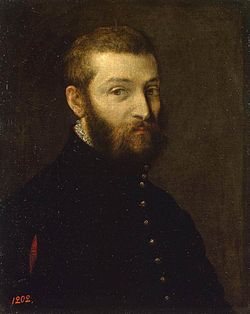
Back Paolo Veronese Afrikaans باولو فرونزه Arabic پولو فرونزه ARZ Paolo Veronese AST Paolo Veroneze Azerbaijani Паоло Веронезе Bashkir Паала Веранезэ Byelorussian Паолё Вэранэзэ BE-X-OLD Паоло Веронезе Bulgarian ཕའོ་ལོ་ཝེ་རོ་ནེ་ཟེ། Tibetan
Paolo Veronese | |
|---|---|
 Self-portrait, 1558–1563, Hermitage Museum | |
| Born | 1528 Verona, Venetian Republic |
| Died | 19 April 1588 (aged 59–60) Venice, Venetian Republic |
| Nationality | Venetian |
| Known for | Painting |
| Notable work | The Wedding at Cana (1563) The Feast in the House of Levi (1573) |
| Movement | Renaissance, Mannerism, Venetian School |
| Patron(s) | Barbarigo family, Barbaro family |
| Signature | |
Paolo Caliari (1528 – 19 April 1588), known as Paolo Veronese (/ˌvɛrəˈneɪzeɪ, -zi/ VERR-ə-NAY-zay, -zee, US also /-eɪsi/ -see; Italian: [ˈpaːolo veroˈneːze, -eːse]), was an Italian Renaissance painter based in Venice, known for extremely large history paintings of religion and mythology, such as The Wedding at Cana (1563) and The Feast in the House of Levi (1573). Included with Titian, a generation older, and Tintoretto, a decade senior, Veronese is one of the "great trio that dominated Venetian painting of the cinquecento" and the Late Renaissance in the 16th century.[1] Known as a supreme colorist, and after an early period with Mannerism, Paolo Veronese developed a naturalist style of painting, influenced by Titian.[2]

His most famous works are elaborate narrative cycles, executed in a dramatic and colorful style, full of majestic architectural settings and glittering pageantry. His large paintings of biblical feasts, crowded with figures, painted for the refectories of monasteries in Venice and Verona are especially famous, and he was also the leading Venetian painter of ceilings. Most of these works remain in situ, or at least in Venice, and his representation in most museums is mainly composed of smaller works such as portraits that do not always show him at his best or most typical.
He has always been appreciated for "the chromatic brilliance of his palette, the splendor and sensibility of his brushwork, the aristocratic elegance of his figures, and the magnificence of his spectacle", but his work has been felt "not to permit expression of the profound, the human, or the sublime", and of the "great trio" he has often been the least appreciated by modern criticism.[1] Nonetheless, "many of the greatest artists ... may be counted among his admirers, including Rubens, Watteau, Tiepolo, Delacroix, and Renoir".[3]